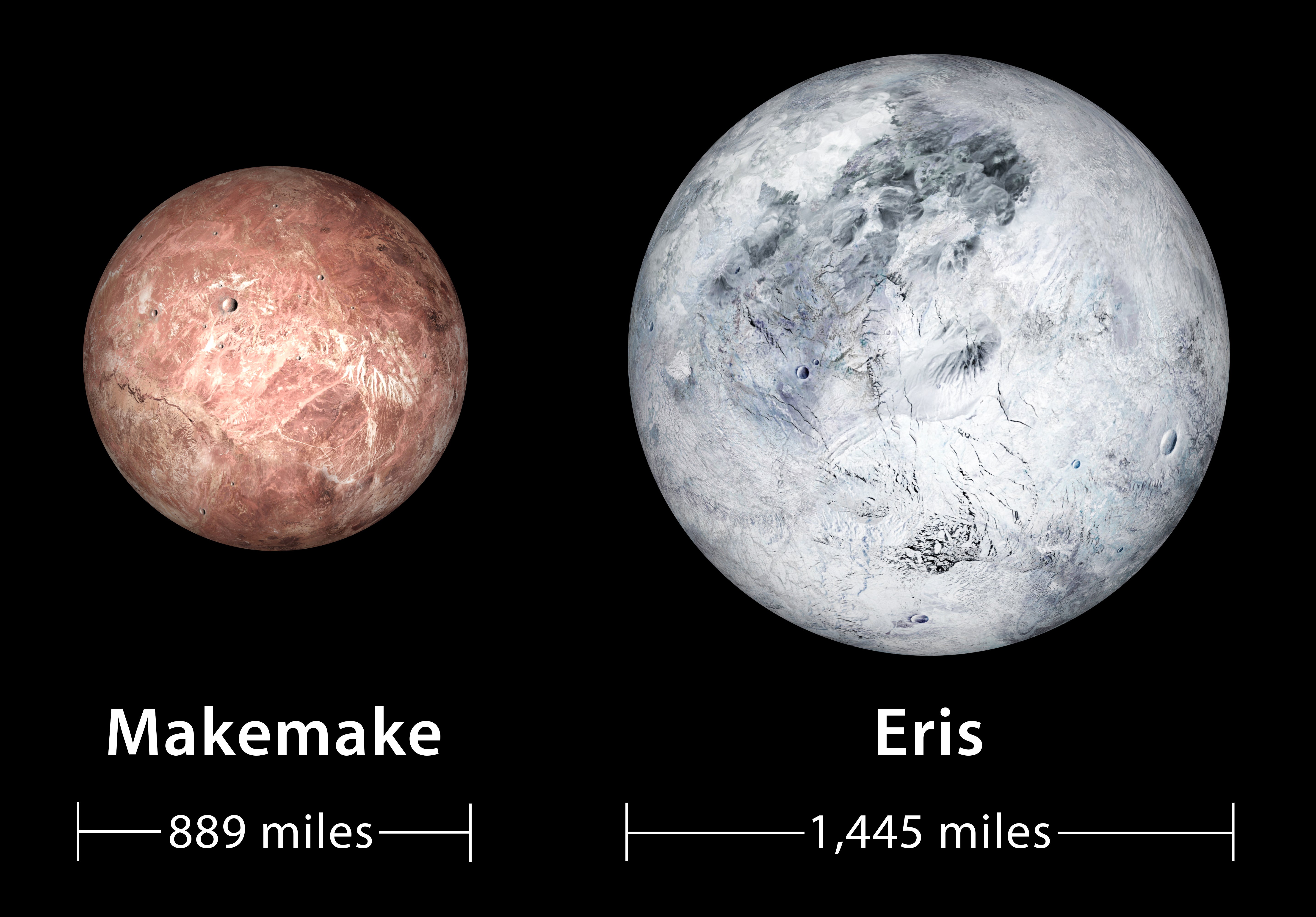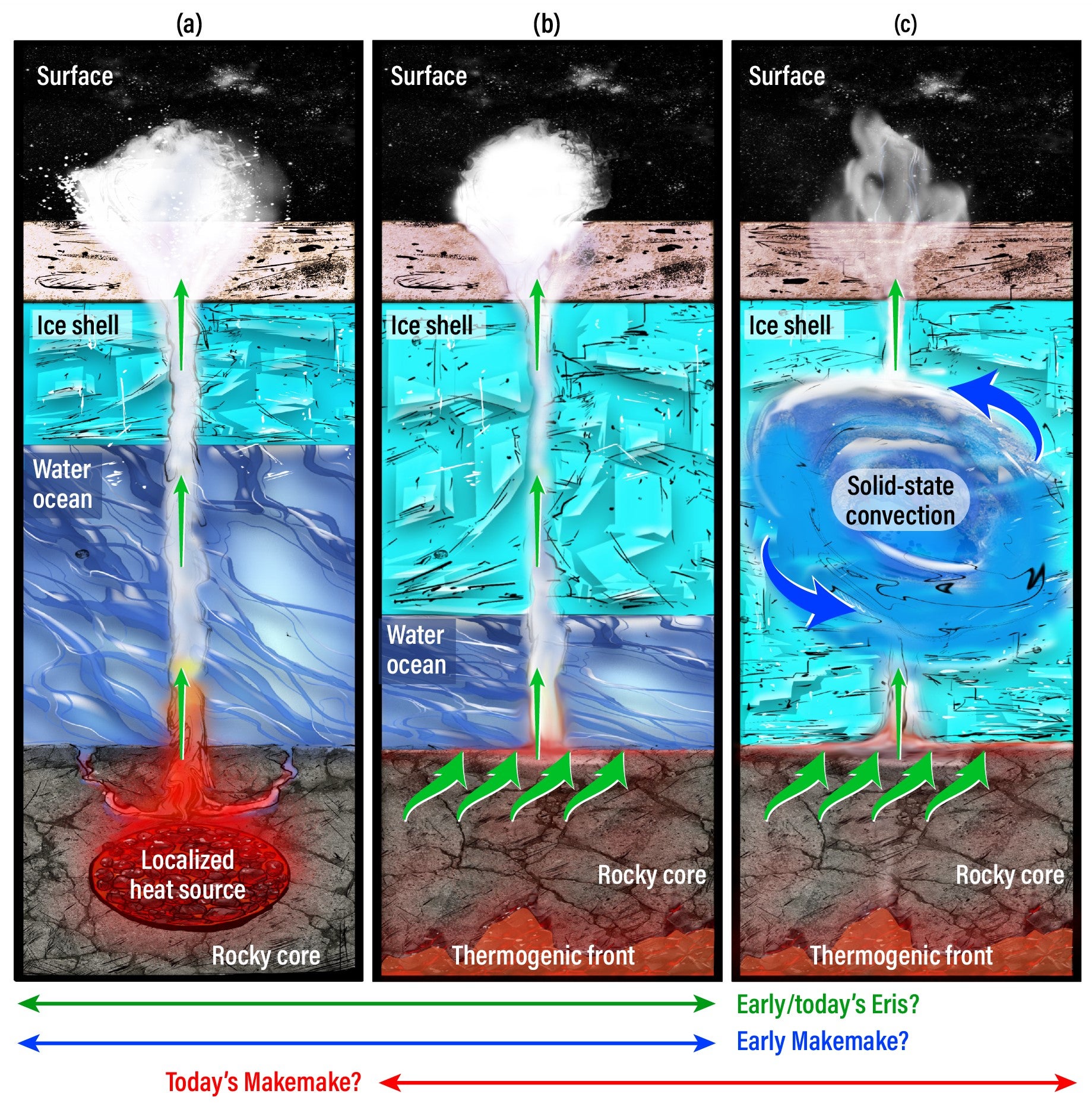
The vast, icy Kuiper Belt isn’t high on the list of places you’d think have relatively active worlds, but a pair of new studies shows that at least two dwarf planets are possibly geologically active.
The studies — both published in Icarus — look at something astronomers already knew: that Eris and Makemake, the second and fourth largest dwarf planets in our solar system, contain a lot of methane. But because the worlds are small and remote, astronomers couldn’t really find out much about the methane, what might be producing it, or what other chemicals are present.
“From Earth or from the Hubble Space Telescope, you can collect the spectra of Eris and Makemake, but those observations were limited to shorter wavelengths, and it turns out the longer wavelengths are where you can really identify certain key molecules and other features,” says Christopher Glein, a Southwest Research Institute planetary scientist and author on both papers.
What you need, then, is a telescope capable of seeing in those longer wavelengths. Something with a lot of light gathering power to draw out more details from these remote worlds.
Enter JWST, the largest space telescope of all time.
The evidence for geologic activity
Using Webb data taken from August 2022 for Eris and January 2023 for Makemake, Glein and his colleagues analyzed spectra from both worlds. This included analyzing ices on both bodies. What they found were methane bands throughout, which isn’t unexpected — Pluto has methane ices on its surface. But the presence of deuterium, an isotope of hydrogen, in some of the methane, suggested that the methane was coming from a hot environment. Methane normally exists as one carbon and four hydrogen atoms, but deuterium, as a heavier form of the element, may have formed under substantially more extreme conditions. This suggests it may be coming from under the surfaces of these worlds, strongly indicating that Eris and Makemake are geologically active.
“We thought that that was really cool,” Glein says. “Then we spent the next year or so trying to figure out what that is really telling us about how these bodies formed or the histories of these worlds.”
One thing it shows is that rather than frozen remnants of the solar system’s past, Eris and Makemake are worlds with active internal processes. This could mean a lot of things, up to and including oceans inside. “I thought these were going to be big comets or something where they would just be these frozen remnants of the solar nebula,” says Glein.
At the very least, this indicates an icy boundary hitting a rocky core. That rocky core could have localized hot spots that keep an oceanic layer warm enough to transport methane and other chemicals to the surface via geysers. Convection in the core could also create a shallower ocean that still manages to expel chemicals to the surface. A third possibility is that convection drives up the methane through the ices without necessarily passing through an oceanic layer. (It may also be, as the paper mentions, that two different mechanisms are at work simultaneously on either world.)
The methane is unlikely to have a biological source, the paper says, although the presence of an ocean means that life could be there.

Glein says these observations are about as good as we can get from JWST, but that other dwarf planets could provide a good basis of comparison. This includes worlds we haven’t explored yet, such as Haumea or Quaoar or any number of medium-sized dwarf planets, or worlds we have, such as Pluto and Neptune’s moon Triton. Pluto was explored via the New Horizons flyby in 2015, and Voyager 2 swept by Triton in 1989. (Will Grundy, a scientist on the New Horizons mission, is an author on both Icarus papers, and Heidi Hammel, a Voyager scientist, is an author on one of the papers.)
Triton is important as what Glein calls a “cousin” of the Kuiper Belt dwarf planets. It’s likely that Triton was captured from the Kuiper Belt into its orbit around Neptune, and has a lot of chemical similarities to Pluto. (And thus, likely, to Eris and Makemake.) Earth, Venus and Mars appear pretty similar, compositionally, Glein says, but all act in different ways — which could be the same relationship with these worlds.
“I think it’d be really great to try to get into this comparative mode where we try to see, okay, what’s similar and what’s different in terms of their compositional signatures?,” says Glein. “What can that tell us about common modes of how they formed and evolved? Or could there be alternative pathways that different belt objects took for some reasons that we haven’t quite figured out yet?”
But there’s another way to get more data: send something to one or more of these worlds.
“It’s not too soon to start thinking about sending something like a New Horizons out to one of these other bodies and try to get a sense of what’s going on on a different world than Pluto,” Glein says.









